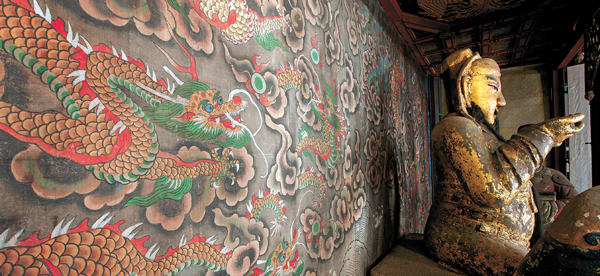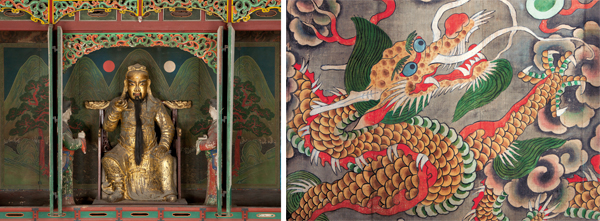Sublime dragon work discovered in a shrine

A three- to four-century-old painting of dragons provided a backdrop for a gilt bronze statue of Gwanwu, a legendary warrior, in the Dongmyo Shrine in Jongno, central Seoul. Provided by Choi Ho-sik
One dragon after another emerged from three or four centuries of obscurity as the authorities pulled out the iron nails and removed a seven-part folding screen featuring a famous landscape of a sun, moon and five mountaintops.
A total of nine dragons - one white, one blue and seven yellow - were playing in the clouds.
The biggest dragon-painting of the Joseon Dynasty (1392-1910) was recently discovered at the Dongmyo Shrine in Sungin-dong, Jongno in central Seoul, the JoongAng Ilbo discovered through a “Report on Preliminary Academic Investigation on Relics at Dongmyo Shrine.” The Jongno District Office published the report recently.
The painting - measuring 2.75 meters (9 feet) in height and 4.95 meters in length - was discovered in October 2011 as cultural artifacts experts were doing an inventory of artifacts at the shrine. The painting was on a wall behind a gilt bronze statue of Gwanwu (160-219), a legendary warrior from China’s Three Kingdoms period (220 ? 280) and also the subject of worship by some Chinese believers.
A folding screen showing a landscape in seven parts had been placed over the wall painting and nailed to the wall.
“Judging from the condition, it appears the painting has never been uncovered or removed from the wall since it was created in the 17th century,” said Jang Gyeong-hee, a professor of cultural heritage conservation at Hanseo University’s fine arts department, who wrote the report.
“Thanks to the folding screen, air was blocked and dust was kept away, allowing the colors to remain vivid all these years.”

Left: The screen that hid the painting for centuries has been restored and hides the dragons once more. Right: A detail of the dragon painting Provided by Choi Ho-sik
The shrine, also known as Donggwanwangmyo, was built in 1602 for Gwanwu. The costs were covered by an emperor of the Ming Dynasty, which helped Joseon fight off the Japanese during the 16th-century Imjin invasion attempts of Korea.
The shrine, Korea’s treasure No. 142, was to commemorate the spirit of Gwanwu. Dragons were symbols of kings, and Gwanwu was revered as a kind of king, historians say.
But dragon-paintings at Joseon palaces are extremely rare because many were destroyed during the Imjin invasion attempts. The only remaining dragon painting at a Joseon palace is at Gyeongbok Palace, and it is smaller than the recently discovered one. Most Joseon-era dragon paintings feature one or two dragons, while the one at Dongmyo features nine, which are more common in Chinese paintings.
It is unclear when the painting was hidden behind the screen. Historians assume that it was at some point in the Joseon era, given that the iron nails that bolted the screen to the wall were in the style of Joseon blacksmith shops.
It’s also not known why the numerous restorations of the shrine since the 1960s failed to find the painting.
Officials at the shrine have covered the painting with the folding screen once again, triggering concerns from art historians. They say it’s urgent that the painting be studied in-depth.
“Besides the dragon painting, the shrine has many high-quality paintings and craft works,” said An Hui-jun, art history professor of Seoul National University. “It is necessary to seek ways to better manage and utilize them.”
By Lee Yeong-hee, Kim Hyung-eun [hkim@joongang.co.kr]










with the Korea JoongAng Daily
To write comments, please log in to one of the accounts.
Standards Board Policy (0/250자)